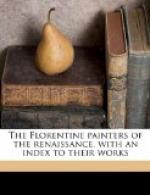Pontormo, who had it in him to be a decorator and portrait-painter of the highest rank, was led astray by his awe-struck admiration for Michelangelo, and ended as an academic constructor of monstrous nudes. What he could do when expressing himself, we see in the lunette at Poggio a Caiano, as design, as colour, as fancy, the freshest, gayest, most appropriate mural decoration now remaining in Italy; what he could do as a portrait-painter, we see in his wonderfully decorative panel of Cosimo dei Medici at San Marco, or in his portrait of a “Lady with a Dog” (at Frankfort), perhaps the first portrait ever painted in which the sitter’s social position was insisted upon as much as the personal character. What Pontormo sank to, we see in such a riot of meaningless nudes, all caricatures of Michelangelo, as his “Martyrdom of Forty Saints.”
[Page heading: BRONZINO]
Bronzino, Pontormo’s close follower, had none of his master’s talent as a decorator, but happily much of his power as a portrait-painter. Would he had never attempted anything else! The nude without material or spiritual significance, with no beauty of design or colour, the nude simply because it was the nude, was Bronzino’s ideal in composition, and the result is his “Christ in Limbo.” But as a portrait-painter, he took up the note struck by his master and continued it, leaving behind him a series of portraits which not only had their effect in determining the character of Court painting all over Europe, but, what is more to the point, a series of portraits most of which are works of art. As painting, it is true, they are hard, and often timid; but their air of distinction, their interpretive qualities, have not often been surpassed. In his Uffizi portraits of Eleanora di Toledo, of Prince Ferdinand, of the Princess Maria, we seem to see the prototypes of Velasquez’ queens, princes, and princesses: and for a fine example of dignified rendering of character, look in the Sala Baroccio of the Uffizi at a bust of a young woman with a missal in her hand.
XIV.
[Page heading: MICHELANGELO]
The great Florentine artists, as we have seen, were, with scarcely an exception, bent upon rendering the material significance of visible things. This, little though they may have formulated it, was the conscious aim of most of them; and in proportion as they emancipated themselves from ecclesiastical dominion, and found among their employers men capable of understanding them, their aim became more and more conscious and their striving more energetic. At last appeared the man who was the pupil of nobody, the heir of everybody, who felt profoundly and powerfully what to his precursors had been vague instinct, who saw and expressed the meaning of it all. The seed that produced him had already flowered into a Giotto, and once again into a Masaccio; in him, the last of his race, born in conditions artistically most propitious, all the energies remaining in his stock were concentrated, and in him Florentine art had its logical culmination.




